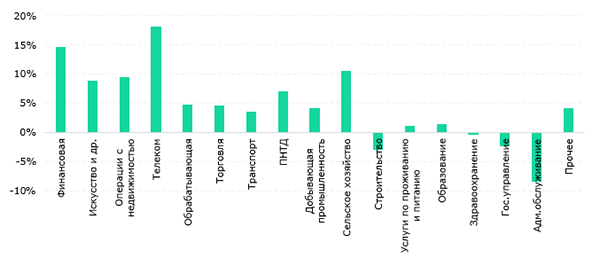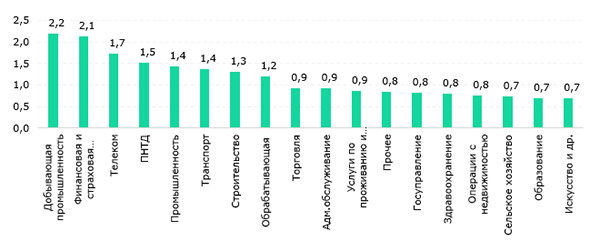By the end of the third quarter, the average salary in the country reached 390,000 tenge, reflecting a real increase of 2.7% year-on-year, as reported by inbusiness.kz citing the analytical center Halyk Finance.
Wages grew most rapidly in the telecommunications, finance, and agriculture sectors, where growth rates were in double digits. A decline in earnings for hired workers continues to be observed in construction, healthcare, public administration, and the administrative services sector.
The highest salary growth at the end of the third quarter was seen in telecommunications (18.2% year-on-year), finance (14.7% year-on-year), and agriculture (10.6% year-on-year), which approximately mirrors the trends of the first two quarters. However, in the latter sector, the salary remains one of the lowest in the economy at 284,000 tenge. The highest earnings have consistently been maintained in finance (831,000 tenge), mining (854,000 tenge), and telecommunications (673,000 tenge).
Figure 1. Dynamics of real wages by economic sectors (year-on-year) for the third quarter of 2024

Source: BNS
Note: PNTD = professional and scientific-technical activities
At the same time, only 9% of the employed population works in these three high-earning sectors, while more than 50% of hired workers are employed in healthcare, education, and public administration, where earnings are below average. Furthermore, in healthcare and public administration, salaries continue to decline in real terms (-0.4% year-on-year and -2.3% year-on-year, respectively), while a slight increase (1.4% year-on-year) was observed in education after declines in the first two quarters of this year.
"We have already noted that such a trend of declining real wages emerged in state-dominated sectors starting in 2023. From 2019 to 2022, salaries in education, healthcare, and public administration often grew at double-digit rates. The cessation of growth incentives in these areas following active policies in previous years has led to a rapid change in dynamics," writes analyst Madina Kabzhalyalova.
Figure 2. Salaries by economic sectors relative to the average salary (average salary=1)

Source: BNS
Real earnings continue to show recovery after a record decline in growth rates in 2023, when high inflation nearly nullified the real growth of wages. Despite a significant decrease in inflation this year, salary growth still lags behind economic growth, which amounted to 4% year-on-year over the first nine months of 2024, whereas historically, the growth of hired workers' wages has significantly outpaced economic growth, analysts from HF note.